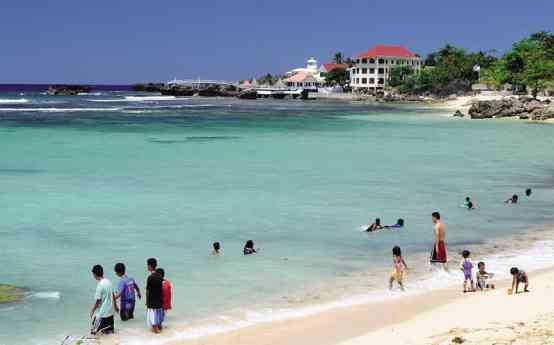
THE COASTAL village of Patar in Bolinao, Pangasinan, boasts of a long stretch of white sand beach.
At right, Patar’s famous landmark, the Cape Bolinao lighthouse, stands near where a fish hatchery is proposed to be built. PHOTOS BY WILLIE LOMIBAO
This month, the residents flexed their muscles once more to block a fish hatchery project, arguing that it would destroy their ecotourism area.
Feedmix Specialists Inc., an animal feeds manufacturer, is developing a fish hatchery in Patar, a coastal village facing the West Philippine Sea. The area boasts of a long stretch of white sand and coral line beaches, which, some tourists say, are better than those found in Aklan’s Boracay.
In its project brief, Feedmix said the proposed hatchery would be a “state of the art, multispecies hatchery” for high-value fish, such as ‘bangus’ (milkfish), pompano, shrimp, sea bass and groupers. It plans to produce 20 to 30 million bangus fries, 300,000 to 500,000 pompano, and 100,000 groupers every month.
The company refused to answer the Inquirer’s queries about how it acquired the Patar land. It was not clear if it also acquired environmental permits for the project.
The proposed hatchery will be built below the Cape Bolinao lighthouse in Patar, 6 kilometers from the Balingasay River. According to the University of the Philippines’ Marine Science Institute (UPMSI) based in Bolinao, the hatchery will require 34,609 square meters (sqm) of land.
“[But] the lease contract for the proposed site indicates a smaller area (25,280 sqm). Although it is not specified in the plan, it is presumed that the hatchery will be constructed along or near a shore,” said a comment signed by UPMSI Deputy Director Ronald Villanueva.
“As foreshore land could be covered by the facility, this will require the acquisition of a foreshore lease agreement from DENR (Department of Environment and Natural Resources),” it added.
Margaret Celeste, chair of the Movement of Bolinao Concerned Citizens Inc. (MBCCI), said the “big” hatchery “will raise ‘sabalo’ (mother milkfish) and other fish and they will be using feeds and chemicals. These will have a long term effect on the pristine waters of Patar.”
Ecotourism zones
The MBCCI is a broad coalition of nongovernment organizations that spearheaded the protest against a P13-billion cement plant project in the town in 1994. The DENR denied the issuance of an environmental compliance certificate for the project in 1997.
“It’s not that we do not like the hatchery. We just want them to relocate elsewhere,” Celeste said.
The coastal areas of Bolinao, a third-class municipality (annual income: P35 million to P45 million) of nearly 75,000, have been divided into zones dedicated exclusively to ecotourism, fisheries management, trade and navigation, and a zone for multiple uses.
“Based on this, they should build their hatchery inside the multiple-use zone where our aquaculture activities are located,” Celeste said.
She also challenged Feedmix’s sincerity, claiming that the company started building in Patar three years ago without seeking a building permit from the municipal government.
“In 2012, the barangay (village) captain noticed the structure, which can be seen from the lighthouse. We thought it was just a big house or a resort,” she said.
It was only when the municipal government stopped the construction that residents learned it was a fish hatchery project.
Celeste said Feedmix distributed flyers, informing residents it was building a hatchery, with a fisheries school, an oceanarium and villas. Recently, she said, Feedmix had described its Patar project as a hatchery and an ecolearning center.
During a March 20 public hearing on the hatchery project, Feedmix officials apologized to residents and officials for committing these missteps.
“We ask for apology to the town and all stakeholders for starting the project without a permit, with no public hearing and [without advising] the barangay. We have no bad intentions and we are willing to go through the process,” said lawyer Ramon Perdon, Feedmix counsel.
Perdon said the project’s name had been changed to Cape Bolinao Sustainable Marine Finfish Hatchery and Eco-Learning Center. “In essence, this is a hatchery. We will not build a feed mill,” he said.
Joebert Toledo, Feedmix consultant, said no waste water would be released to the sea during the hatchery operations.
“If there is, it will already be clean,” said Toledo, who is former chief of the aquaculture department of the Southeast Asian Fisheries Development Center in Iloilo province.
In expressing their opposition to the project, Ronnie Torres, president of the Bolinao Hotel, Resort, Restaurant Owners’ Association, said Feedmix only has to look at the municipality’s coastal development plan. “Should their project be built within the ecotourism zone?” he asked.